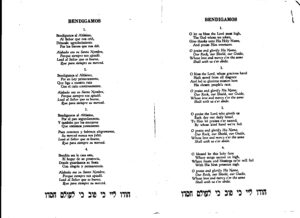Composition sung by Shearith Israel Choir on Shabbat Hanukkah
This composed “Min HaMetser” is sung by the Choir of Congregation Shearith Israel sometime around 9:30 am on the morning service for the Shabbat of Hanukkah, during the Hallel section. Some time ago it was used for the morning service on Thanksgiving, before the exigencies of parade-watching forced a curtailment of that service. This audio clip was taken from Track 14 of “Choral Music of Congregation Shearith Israel,” recorded by the Choir of Congregation Shearith Israel in 2003.
The composer of this piece, Jacques–François–Fromental–Élie Halévy (1799-1862), was a famous French operatic composer, born in Paris, son of a Sephardic cantor, Élie Halfon Halévy, who was the secretary of the Jewish Community of Paris. By the age of ten, Jacques-François had entered the Conservatoire de Paris, and there he rose to become a prominent professor of music, numbering among his students Georges Bizet, Adolphe Blanc, and Adolphe Danhauser. Fromental Halévy is best-known for his grand opera “La Juive,” which is a staple of the operatic repertoire. He rose to prominence in France as an arbiter of public artistic tastes, becoming permanent secretary of the Academie des Beaux Arts in 1854. A prolific composer of operas, cantatas, and ballets, Halévy is known to have also composed settings of several Hebrew texts, specifically from the Psalms, such as this section of Psalm 118 “Out of my straits.” Halévy encouraged the composition of 19th-century synagogue music, most notably through his protege, Samuel Naumbourg. Here in New York a century ago there was a famous Halévy Society to which many prominent Jewish musicians belonged, including Leon M. Kramer, who served as Shearith Israel’s choirmaster from 1883-1943.


